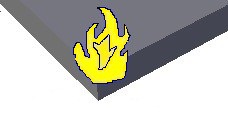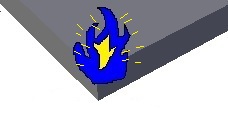Plastics identification through burning (with odor and flame table)
I don't know how I could forget, during all these years that I keep this website, talking about something as important as the identification of plastics through burning. This is a very common process in
recycling companies and aims to identify, for prior separation, the different types of polymers present in a shipment.
The process has no secret, a candle and / or a lighter, tweezers or pliers, are the necessary tools to perform this work. Depending on the type of plastic, a different effect occurs when the flame comes into contact: yellow flame, blue flame, soot release, flame self-extinguishing, etc. In addition, the smoke from burning has a particular odor for each polymeric family, through which, the most experienced recyclers, can even distinguish between the members of that family (eg: polyamide family - members: polyamide 6, polyamide 6.6 etc).
There has been a table circulating on the internet since the early 2000s that shows these burning characteristics, the problem is that it has a series of errors (eg, saying that polyacetal has a styrene monomer odor). In 2004, Hélio Wiebeck and Ana Magda Piva used this table in the book
"Reciclagem de Plásticos" (Plastic Recycling), correcting some errors and keeping a few others.
I reformulated the table and added illustrations (just for visual reference), the result is this:
|
Polymers |
Burning test behavior |
Smoke odor |
Burning illustration |
 |
(L)LDPE, MDPE, HDPE |
Blue flame with yellow apex. Drips like a candle |
Paraffin |
 |
|
PP |
Blue flame with yellow apex. Drips like a candle |
Paraffin but a little tastier than PE |
 |
PMMA |
Blue flame with yellow apex. Bubbles in the piece, burns slowly, and does not carbonize |
Garlic |
 |
 |
PVC |
Yellow flame with green vertex. Self-extinguishing flame |
Chlorine |
 |
 |
ABS |
Yellow flame. It carbonizes and produces smoke with a lot of soot. Burns a little more slowly than PS and SAN |
Burnt rubber and styrene monomer* |
 |
|
PS |
Yellow flame. Carbonizes and produces smoke with a lot of soot |
Styrene monomer* |
| SAN |
Yellow flame with glow. Produces sooty smoke and carbonizes more than PS |
Styrene monomer* |
 |
PC |
Hard to burn, self-extinguishing yellow flame, carbonizes and produces soot |
"Medicine" (imagine the smell of a concentrated pharmacy) |
 |
|
PET |
Yellow flame. Produces a little black smoke |
Characteristic. Use the odor of a burnt bottle as a reference |
 |
 |
POM |
Low, round blue flame, almost invisible, without soot |
Extremely strong odor to the point of causing a momentary headache if the smoke is breathed in deeply |
 |
 |
PU |
Produces a lot of smoke |
Characteristic. Use as a reference the odor of burnt mattress foam |
 |
 |
PA (all) |
Blue flame with yellow apex. It takes time to catch fire, does not generate soot and drips if you keep the fire for a long time |
Burnt hair |
 |
 |
Cellulose acetate |
Yellow flame. Ignites |
Acetic acid |
 |
| Cellulose butyrate acetate |
Blue flame with sparks. Ignites |
Rancid butter |
 |
 |
PTFE |
Does not catch fire, chars |
As it does not burn, it does not emit odor |
 |
* this monomer, when liquid, smells like a thinner, but when polymerized and burned it has a smoother and sweeter odor
Bibliography:
HARPER, Charles A.; PETRIE, Edward M. Plastics Materials and Process: A Concise Encyclopedia. Hoboken: John Wiley & Sons, Inc., 2003.
WIEBECK, Hélio; HARADA, Júlio. Plásticos de Engenharia: Tecnologia e Aplicações. São Paulo: Artliber Editora, 2005.
© 2010-2025 - Tudo sobre Plásticos.
All rights reserved.
Home
-
Privacy policy
-
Contact
















